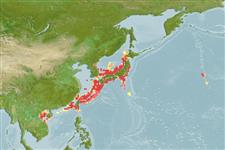>
Perciformes/Scorpaenoidei (Scorpionfishes) >
Sebastidae (Rockfishes, rockcods and thornyheads) > Sebastinae
Etymology: Helicolenus: Greek, helike, -es = spiral + Greek, lenos, -ou = cavity (Ref. 45335).
Eponymy: Dr Franz Martin Hilgendorf (1839–1904) was a German zoologist and palaeontologist. [...] (Ref. 128868), visit book page.
More on author: Döderlein.
Environment: milieu / climate zone / depth range / distribution range
Ecologie
marien demersaal; diepte 150 - 500 m (Ref. 11230). Temperate
Northwest Pacific: Japan and southern Korea to the East China Sea.
Grootte / Gewicht / Leeftijd
Maturity: Lm ? range ? - ? cm
Max length : 27.0 cm SL mannelijk / geslacht onbekend; (Ref. 41299)
Found in sandy mud bottom (Ref. 11230). Viviparous (Ref. 34817).
Levenscyclus en paargedrag
Maturiteit | Voortplanting | Paaien | Eieren | Fecunditeit | Larven
Nakabo, T., 2002. Fishes of Japan with pictorial keys to the species, English edition I. Tokai University Press, Japan, pp v-866. (Ref. 41299)
Status op de Rode Lijst van het IUCN (Ref. 130435: Version 2024-1)
Gevaar voor de mens
Harmless
Gebruik door de mens
Visserij: commercieel
Tools
Speciale rapporten
Download XML
Internetbronnen
Estimates based on models
Preferred temperature (Ref.
123201): 0.9 - 18.4, mean 12.9 °C (based on 47 cells).
Fylogenetische diversiteitsindex (Ref.
82804): PD
50 = 0.5020 [Uniqueness, from 0.5 = low to 2.0 = high].
Bayesian length-weight: a=0.01175 (0.00777 - 0.01776), b=3.16 (3.04 - 3.28), in cm total length, based on LWR estimates for this species & (Sub)family-body (Ref.
93245).
Trofisch niveau (Ref.
69278): 3.2 ±0.40 se; based on food items.
Weerstandsvermogen (Ref.
120179): laag, minimale populatieverdubbelingstijd 4,5-14 jaar (Preliminary K or Fecundity.).
Fishing Vulnerability (Ref.
59153): Low vulnerability (23 of 100).
